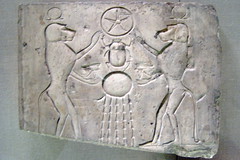My mother sent me a link to a fascinating Scientific American article about zoologist Emily Baird’s research on dung beetles. Egyptologists give these poo-pushing champions the more dignified name of “scarab,” after an ancient Greek word for beetle.
Dr. Baird’s specialty is insect vision, flight and navigation (see her profile at Lund University). She wrote her thesis on honeybees. I’m grateful that she decided to turn her research to the humble dung beetle, Kheper nigroaeneus. Her work may illuminate one of ancient Egypt’s more bizarre gods.
The Ancient Egyptian Insect God
Why did the ancient Egyptians worship a large beetle that rolls a ball of dung, lays its eggs inside it, and then pushes the ball along the ground? Why did the Egyptians call this beetle kheper, with the metaphorical meaning “becoming, to come into being”? Why did they associate the lowly dung beetle with Re, their supreme being and sun god, and give their beetle-god avatar of Re the name Khepri?
Many Pharaohs incorporated kheper into their “throne name,” the official name they assumed at their coronation. King Tut’s treasures are decorated with elaborate cartouches of his throne-name Neb Kheperu Re, “The Lord of Becoming/Manifestation/Creations is Re.” Tourists to Egypt buy scarabs modeled on King Tut’s scarab-jewelry, not realizing that they’re paying homage to dung beetles. Even Barbie has accessorized with them.
Mythological Interpretations of Kheper
Egypt scholars, puzzled over this peculiar god, have offered explanations. Young beetles emerge from their dung-cocoon like the sun rising from the horizon. Therefore, they are a symbol of creation and manifestation. As Khepri, they assure the sun’s rebirth each day.
The ancient Greek naturalist Plutarch, who wrote extensively about Egyptian religion in his own day, has this to say about scarabs:
“One accepts (with the ancient Egyptians), that these varieties are only male beetles, that they put down their seed substance (semen) which forms a ball and the beetle rolls it forward with its widely spaced hind legs so that the beetle imitates the path of the sun as it went down in the west and rose in the east in the mornings.”
— Source: Ancient Egypt: The Sacred Scarab
Dr. Baird’s research may shed light— literally— on one more reason why the ancient Egyptians associated the dung beetle with the sun.
Scarabs as Solar Navigators
Dung beetles present their own puzzle to entomologists. Why on earth do dung beetles frequently pause, climb on top of their dung balls, and do a little dance before resuming their hike?
© Emily Baird, Lund University
Dr. Baird’s research suggests that the beetles climb up to get a sighting of the sun. Their eyes have built-in polarization filters that would allow them to use the sun’s rays like the points of a celestial compass, even on an overcast day. She found that if she blocked the sun from their line of sight and reflected the sun at the beetles with a mirror, they climbed up for a “jitterbug dance” and usually headed off on a different bearing.
If she’s right, the beetles are attuned to the sun’s rays. I can’t help thinking of the Aten, the rayed solar disc that is common in Egyptian art at the time of King Tut. At right, a late-period Egyptian sculpture shows a variant of this rayed disc with baboons worshipping it. The depiction of the beetle is now more accurate: dung beetles push the ball with their hind legs. Th star above the beetle is probably Sirius, which appeared just before sunrise right before the Nile River’s annual flood. (See “Sopdet: Egypt’s Herald of the New Year,” previously covered by Mythphile.)
The Egyptians were close observers of their natural environment. They knew that the beetle pushing the ball was male, although by Plutarch’s day they had forgotten that the female first laid eggs in it. Perhaps they had figured out that the insects’ dance was a way of taking the sun’s bearings. To them, the beetle must have had special sacred knowledge putting it in touch with the supreme being, the sun-god.
Similarly, the Egyptians often represented baboons side-by-side with paws upraised towards the solar disc, worshipping it at sunrise with sacred hymns in their own language. Real-life baboons chatter and sometimes line up to watch the sunrise.
Mythology as the Precursor to Science
Mythologist Joseph Campbell says that the “second function of …traditional mythology” is scientific explanation (Thou Art Thatp. 3). Before logic and scientific experimentation were invented, people created myths— sacred stories— to explain the world around them and imbue it with meaning.
More than that, Campbell says, these pseudo-scientific explanations helped make sense of the capricious, irrational world, uncovering a comfortingly consistent “order of the cosmos.” (The Greek word for world, “cosmos,” means “order, pattern.”) The Egyptians were eager for and sensitive to repetitive patterns in the natural world, since their lives depended on the rise and fall of the Nile River each year, their only source of water and food. They were terrified of the forces of chaos which might at any moment overwhelm the world once more. For ancient Egyptians, progress was anathema; they prized stability. The wise baboon and the divine dung beetle reassured them of nature’s underlying order.











Leave a Reply
Using Gravatars in the comments - get your own and be recognized!
XHTML: These are some of the tags you can use:
<a href=""> <b> <blockquote> <code> <em> <i> <strike> <strong>